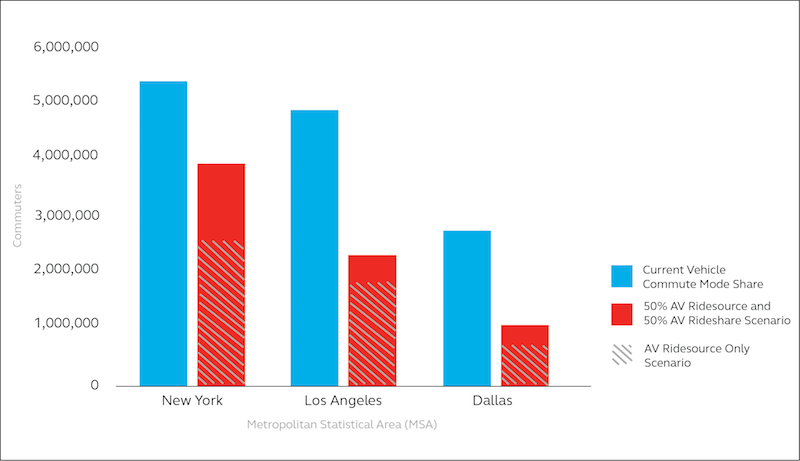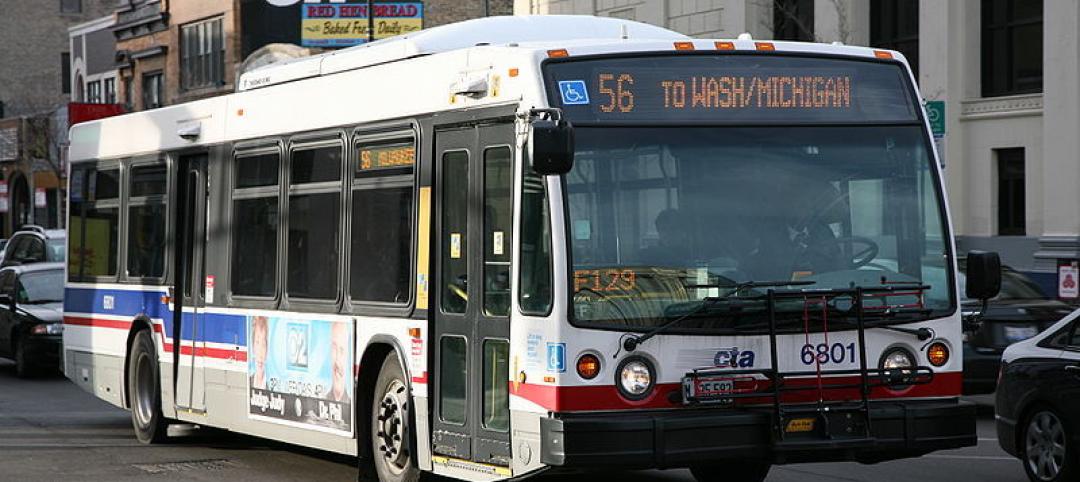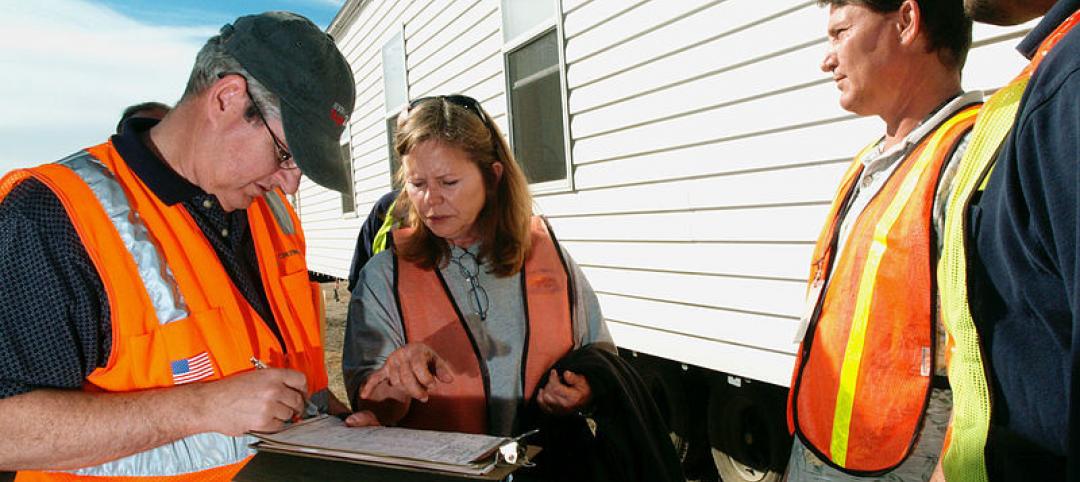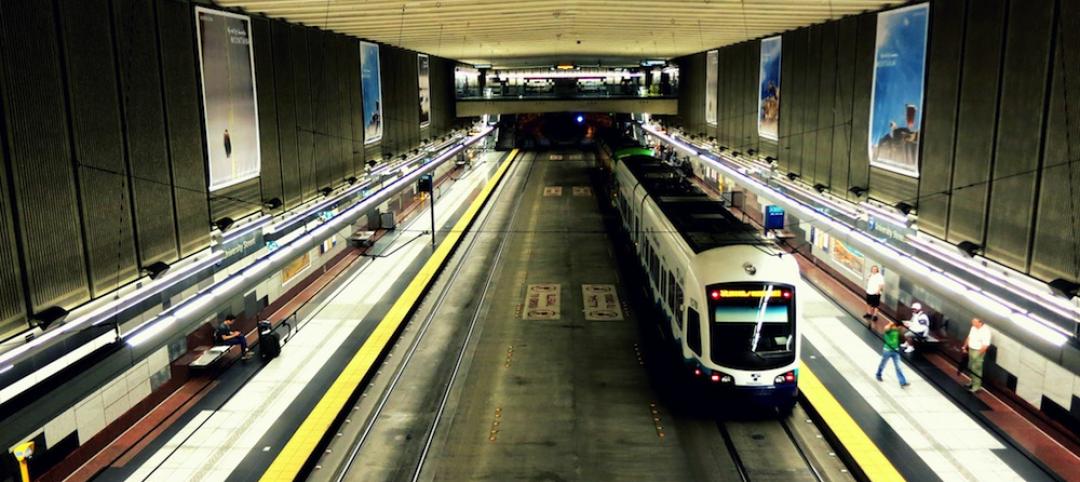A study by transportation, economics and urban planning experts has found that ridesharing and ridesourcing services using autonomous vehicles (AV) could shift millions of drivers away from personal cars in major U.S. cities.
“Driverless Future: A Policy Roadmap for City Leaders,” the study prepared by Arcadis, HR&A Advisors and Sam Schwartz Consulting, shows that the move to ridesharing and ridesourcing services that don’t have a driver could cause a shift of up to 60 percent (3.6 million cars) from traditional to autonomous vehicles in the New York metro area alone over the next 15-20 years.
The Los Angeles metro area could see a shift of up to 44 percent (2.2 million cars) and the Dallas-Ft. Worth metro area could see a shift of up to 31 percent (nearly 1 million cars).
The shift of nearly 7 million drivers to autonomous vehicles across three diverse metro areas illustrates how cities across the U.S. could be greatly impacted and reveals the significant effect of driverless services contemplated by companies such as Uber and Lyft.
To help cities prepare for such profound changes in daily life, Arcadis, HR&A Advisors and Sam Schwartz Consulting are offering a policy road map for complex issues related to autonomous vehicles and their potential impact on equity, public transit, parking, land use, and real estate development.
To prepare for this driverless future, the report identifies six priorities for city leaders:
- Leverage technology to enhance mobility: Cities and private partners should embrace smartcards, open data, and universal apps. This would allow riders to compare, book, and pay for trips that combine buses, trains, bikes and ridesharing. Pilot programs are already in place in cities ranging from Los Angeles to Helsinki.
- Prioritize and modernize public transit: Cities and transit agencies should focus on high-ridership, high-frequency light rail and bus rapid transit systems while driverless shuttles provide first- and last-mile connections for riders. Similar shuttles are already being tested in London and Singapore.
- Implement dynamic pricing: To reduce congestion and create a level playing field between public and private transportation, cities should consider dynamic road pricing plans that vary by origin and destination, number of passengers, congestion, and/or household income. This can be implemented through proven tools such as congestion pricing, zone pricing, vehicle-miles traveled fee, etc.
- Plan for mixed-use, car-light neighborhoods: AV can unlock demand for living and working in mixed-use neighborhoods – whether they are urban or suburban. To shape this demand, cities need to plan for and incentivize mixed-use development, overhaul parking requirements, and reevaluate new transit projects.
- Encourage adaptable parking: Fewer personal cars means fewer parking spaces, especially in city centers where much of the land use is taken by parking garages or lots. Parking garages need to be built with housing or office conversion in mind and include level floors, higher ceiling heights and centralized ramps. These future-proof garages are already being contemplated in Boston and Nashville.
- Promote equitable access to new jobs and services: To support disadvantaged populations, cities must encourage public and private operators to provide alternative payment methods, access via dial-a-ride and equitable service coverage. Cities and private partners must also create new employment and training opportunities for drivers and others in legacy occupations.
The full report can be found here.
Related Stories
Industry Research | May 11, 2016
Why corporate bathrooms stink and how good design can fix this
Despite their importance, bathrooms are often overlooked when it comes to building design. Gensler's Johnathan Sandler spoke with people in the industry and detailed some of the biggest gripes.
Big Data | May 5, 2016
The Center for Neighborhood Technology has launched the largest source of transit data in the country
AllTransit analyzes the social benefits of good transit service by analyzing data related to health, equity, and economic development.
Industry Research | May 5, 2016
National survey reveals offices aren’t built to benefit employees
A Saint-Gobain and SageGlass Work Environment Survey found insufficient access to daylight, poor air quality, and distracting noise at workplaces as the major issues experienced by employees
Industry Research | Apr 15, 2016
Commercial construction starts jumped 18% in March
Nonresidential construction has gotten off to a hot start this year and looks to gain even more momentum throughout the spring.
Industry Research | Apr 14, 2016
Contractor confidence down, but not out
Despite a slight regression, nonresidential construction confidence is still in positive territory
Industry Research | Apr 7, 2016
CBRE provides latest insight into healthcare real estate investors’ strategies
Survey respondents are targeting smaller acquisitions, at a time when market cap rates are narrowing for different product types.
Industry Research | Apr 4, 2016
AIA: Public-private partnerships could solve nation’s public infrastructure crisis
A new white paper addresses the nation’s $3 trillion public infrastructure crisis and how public private partnerships offer a possible solution.
Retail Centers | Mar 16, 2016
Food and technology will help tomorrow’s malls survive, says CallisonRTKL
CallisonRTKL foresees future retail centers as hubs with live/work/play components.
Architects | Mar 11, 2016
AIA survey finds many women and minority architects still feeling underrepresented and unfulfilled
Dissatisfaction with “work-life balance” and compensation are cited as reasons why companies’ diversity strategies may be faltering.
Office Buildings | Feb 26, 2016
Benching, desking, and (mostly) paper-free: Report identifies top trends in workplace design for 2016
The report, from Ted Moudis Associates, encompasses over 2.5 million sf of workspace built over the past two years.
















